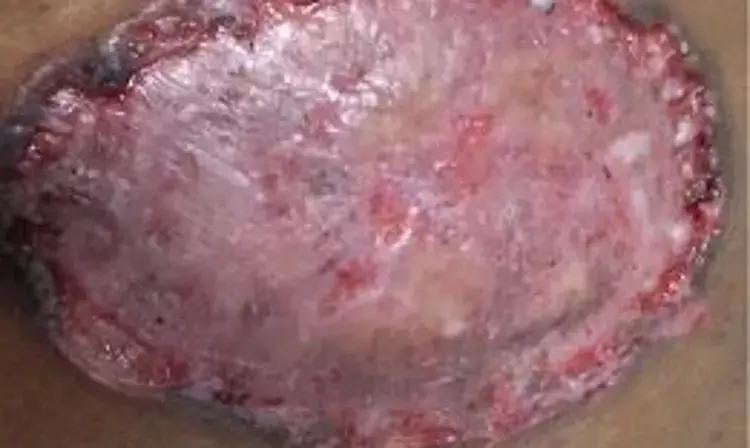- Home
- Medical news & Guidelines
- Anesthesiology
- Cardiology and CTVS
- Critical Care
- Dentistry
- Dermatology
- Diabetes and Endocrinology
- ENT
- Gastroenterology
- Medicine
- Nephrology
- Neurology
- Obstretics-Gynaecology
- Oncology
- Ophthalmology
- Orthopaedics
- Pediatrics-Neonatology
- Psychiatry
- Pulmonology
- Radiology
- Surgery
- Urology
- Laboratory Medicine
- Diet
- Nursing
- Paramedical
- Physiotherapy
- Health news
- Fact Check
- Bone Health Fact Check
- Brain Health Fact Check
- Cancer Related Fact Check
- Child Care Fact Check
- Dental and oral health fact check
- Diabetes and metabolic health fact check
- Diet and Nutrition Fact Check
- Eye and ENT Care Fact Check
- Fitness fact check
- Gut health fact check
- Heart health fact check
- Kidney health fact check
- Medical education fact check
- Men's health fact check
- Respiratory fact check
- Skin and hair care fact check
- Vaccine and Immunization fact check
- Women's health fact check
- AYUSH
- State News
- Andaman and Nicobar Islands
- Andhra Pradesh
- Arunachal Pradesh
- Assam
- Bihar
- Chandigarh
- Chattisgarh
- Dadra and Nagar Haveli
- Daman and Diu
- Delhi
- Goa
- Gujarat
- Haryana
- Himachal Pradesh
- Jammu & Kashmir
- Jharkhand
- Karnataka
- Kerala
- Ladakh
- Lakshadweep
- Madhya Pradesh
- Maharashtra
- Manipur
- Meghalaya
- Mizoram
- Nagaland
- Odisha
- Puducherry
- Punjab
- Rajasthan
- Sikkim
- Tamil Nadu
- Telangana
- Tripura
- Uttar Pradesh
- Uttrakhand
- West Bengal
- Medical Education
- Industry
Low dose clofazimine effective in superficial pyoderma gangrenosum

Source- Mohan AJ, Balakrishnan S, Ambooken B, Ajithkumar K, Asokan N. Superficial variant of pyoderma gangrenosum successfully treated with lower dose clofazimine. Indian Dermatol Online J 2022;13:114-5.
Low dose clofazimine effective in superficial pyoderma gangrenosum - Pyoderma gangrenosum (PG) is a type of neutrophilic dermatoses of the skin. Superficial pyoderma gangrenosum (SPG) s a variant of PG first described by Jones and Winkelmann. It has an indolent course, granulomatous infiltrate in histology, and no underlying systemic disease. Recently a case of SPG with uncontrolled diabetes mellitus (DM) successfully being treated with low‑dose clofazimine was reported in the Indian Dermatology Online Journal.
A 54‑year‑old female presented with painless gradually enlarging ulcers on the left breast, upper back, and left flank of one and half year duration. They failed to heal in spite of multiple courses of antibiotics. These were 3 non-indurated ulcers with irregular, violaceous undermined margins on the left side of the waist, breast, and upper back. The floor of the ulcers showed pink granulation tissue with hemorrhagic crusting. Rest examination was unremarkable. Differential diagnoses of blastomycosis like pyoderma, atypical mycobacterial infection, deep fungal infection, and SPG were considered.
Pus swab yielded Escherichia coli, sensitive to gentamicin, cotrimoxazole, and piperacillin –tazobactum. AFB and fungal cultures were negative. Blood parameters were normal except for a raised blood sugar (FBS‑230mg/ dL) and elevated thyroid‑stimulating hormone (11.3mIU/L). Upper GI endoscopy and CECT abdomen did not show evidence of malignancy. Pathergy test was negative. Skin biopsy showed central necrotizing suppurative inflammation with perivascular and periappendageal lymphocytic infiltrate and leukocytoclasia. Special stains for bacteria, fungus, and AFB were negative. The findings were consistent with PG though the typical granulomatous histology was lacking.
She was treated with piperacillin‑tazobactum as per the culture and sensitivity report, followed by a trial of betamethasone dipropionate cream. As the response was poor, the authors added clofazimine 100mg twice daily. There was a good clinical response in 10 days. The ulcer on the breast healed completely in 4 weeks, and the one on the left flank and upper back healed in 8 weeks leaving cribriform scars. The authors continued the same dose for 12 weeks and then continued at a dose of100 mg daily for another 8 weeks. No new lesions developed thereafter.
The patient had underlying uncontrolled DM and hypothyroidism which is unusual in SPG. The authors prefer to term this entity as "spontaneous idiopathic neutrophilic ulcer" rather than SPG as it is clinically and histopathologically different from pyoderma gangrenosum (PG) (which itself is a misnomer).
Clofazimine was first successfully used in PG in 1976 at a dose of 300–400 mg/day in eight cases. There are a few similar reports of SPG showing a good response to 300mg of clofazimine. The authors started the patient on clofazimine in view of uncontrolled diabetes, and many reports of PG showing clinical response to this agent. Although the exact mechanism of action of clofazimine is unknown, the anti‑inflammatory action of clofazimine is considered pivotal for its efficacy in PG.
To conclude this report emphasizes the role of clofazimine, a cheap and safe drug for the treatment of SPG.
Source- Mohan AJ, Balakrishnan S, Ambooken B, Ajithkumar K, Asokan N. Superficial variant of pyoderma gangrenosum successfully treated with lower dose clofazimine. Indian Dermatol Online J 2022;13:114-5.
MBBS
Dr Manoj Kumar Nayak has completed his M.B.B.S. from the prestigious institute Bangalore medical college and research institute, Bengaluru. He completed his M.D. Dermatology from AIIMS Rishikesh. He is actively involved in the field of dermatology with special interests in vitiligo, immunobullous disorders, psoriasis and procedural dermatology. His continued interest in academics and recent developments serves as an inspiration to work with medical dialogues.He can be contacted at editorial@medicaldialogues.in.
Dr Kamal Kant Kohli-MBBS, DTCD- a chest specialist with more than 30 years of practice and a flair for writing clinical articles, Dr Kamal Kant Kohli joined Medical Dialogues as a Chief Editor of Medical News. Besides writing articles, as an editor, he proofreads and verifies all the medical content published on Medical Dialogues including those coming from journals, studies,medical conferences,guidelines etc. Email: drkohli@medicaldialogues.in. Contact no. 011-43720751


